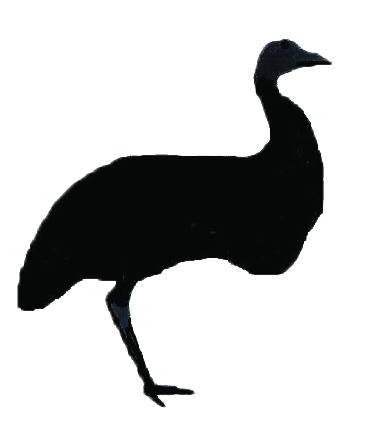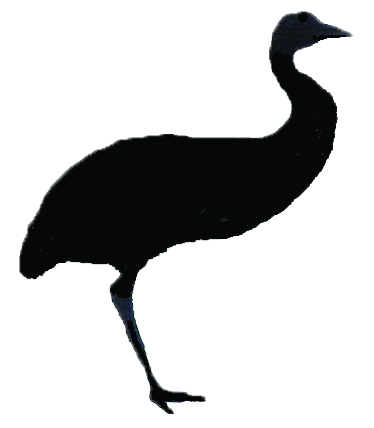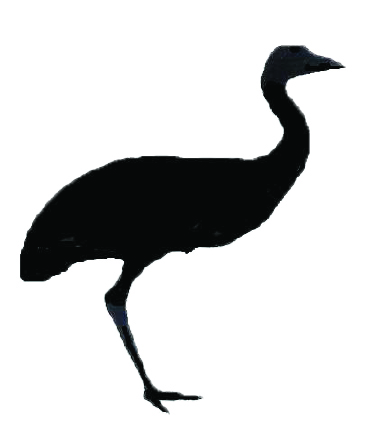General Emu Fact Sheets
The following two printable general emu fact sheets provide a factual overview of the emu. Including anatomy, chicks, meat, eggs, feathers, leather, fat and oil. These sheets were created for teachers, but are relevant to anyone seeking more general information about emus.
Facts for the Teacher, print the pdf brochure
Facts for the Teacher about Dromaius novaehollandiae, print the pdf brochure
FACTS FOR THE TEACHER
From the American Emu Association: About Dromaius novaehollandiae
Dromaius novaehollandiae
A large cursorial bird, Dromaius novaehollandiae originated in Australia but is raised on farms throughout the United States for it’s lean red meat and food by-products such as fat, hide and feathers. Dromaius novaehollandiae actually consists of three subspecies of emu.
As you look at the birds being raised on emu farms, can you guess which of these sub-species were the parent stocks of those birds
The three living sub-species are:
- D. novaehollandiae novaehollandiae
On maturity and during breeding season, these birds have a cream-colored (or whitish) ruff or bib of feathers starting a few inches below the head. The pendulous pouch is larger than in other two sub-species and sways during strut.The metatarsus bone is shorter with a larger diameter. The body is wider than the other two sub-species. This sub-specie originated in southeastern Australia.
D. novaehollandiae novaehollandiae
- D. novaehollandiae woodwardi
On maturity and during breeding season these birds have a ruff or bib of feathers starting a few inches below the head. This ruff appears darker than that of the novaehollandiae novaehollandiae and the pendulous pouch is not as apparent. The body is slender and the legs longer than that of novaehollandiae novaehollandiae. Overall the feathers are paler than the other two subspecies. This sub-specie originated in northern Australia.
D. novaehollandiae woodwardi
- D. novaehollandiae rothschildiOn maturity this bird does not have a ruff or bib. It looks ‘flat-chested’ compared to the other two sub-species. The pendulous pouch is almost non-existent in this emu. Like the novaehollandiae woodwardi, the metatarsus bone is long with a small diameter, making this bird taller than novaehollandiae novaehollandiae. The feathers are the darkest of the three sub-species. This subspecies originates in southwestern Australia.

D. novaehollandiae rothschildi
These three sub-species are interbreeding in both Australia and the United States.
Extinct Species of Dromaius
There are four other known species/sub-species of Dromaius that are now extinct.
- D. ocypus exists only as a fossil
- D. novaehollandiae diemenensis – This subspecies of novaehollandiae was reportedly a large emu with dark feathers. The body type was similar to that of novaehollandiae novaehollandiae. It was found on the large island of Tasmania. The Tasmanian Emu became extinct around 1850.
- D. baudinianus – The Kangaroo Island Emu became extinct around 1827.
- D. ater – King Island Emu – At 4 and half feet tall and weighing under 60 pounds fully grown, this black feathered emu was the smallest of the species. You may find it referred to as d. minor or as the dwarf emu. This emu lived on King Island, the northwestern island in Tasmania, Australia. By 1805 it had been hunted to extinction by sealers and visiting sailors. The one thing these three extinct southern Australia emus have in common is that they all had darker feathers than the mainland emus. For this reason early settlers referred to either black emu or spotted emu. Dromaius novaehollandiae is the spotted emu.
The Pendulous Pouch
In the lower part of the trachea, just before the thoracic inlet, is a segment of trachea comprised of 7 to 12 incomplete rings that form a tracheal diverticulum or open cleft. A very thin membrane covers this cleft. During breeding season this membrane enlarges, creating a pendulous pouch. This pouch is easy to see in females during their first three years of breeding, but in subsequent years does not enlarge as much. Males also have this cleft, but the membrane does not enlarge as much. This cleft is the source of the booming and grunting.
Kingdom Animalia
Phylum Chordata
Subphylum Vertebrata
Class Aves
Order Struthioniformes
Family Dromaiidae (emu)
Genus Dromaius (emu)
Species
- Dromaius baudinianus (extinct)
- Dromaius ater (extinct)
- Dromaius ocypus (extinct)
- Dromaius novaehollandiae
Sub-species
- D. novaehollandiae novaehollandiae
- D. novaehollandiae woodwardi
- D. novaehollandiae rothschildi
- D. novaehollandiae diemenensis (extinct)

Founded in 1989, The American Emu Association is a non-profit trade association representing breeders, producers and marketers of emu meat, oil and other emu co-products. The emu industry is an alternative agricultural industry, dominated by the small farmer, who is devoted to humane and environmentally positive practices that will produce beneficial products for society. For more information about the American Emu Association (AEA) or the emu industry visit http://aea-emu.org